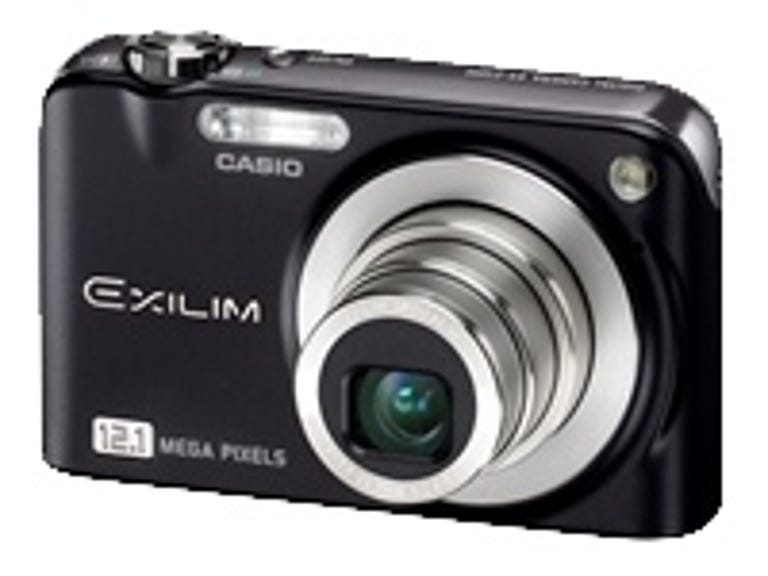 Why You Can Trust CNET
Why You Can Trust CNET Casio Exilim EX-Z1200 review: Casio Exilim EX-Z1200
Casio Exilim EX-Z1200
Megapixels get too much emphasis these days. Most people really don't need more than 6 megapixels to take nice stills that you can edit, crop, post to the Web, or even print out to a respectable size. Larger images can be more trouble than they're worth for casual users, since larger file sizes require more memory and computer power to store, process and edit. That said, higher resolutions can be handy. The more pixels you have in an image, the more you can zoom in and look at fine details, and the larger you can blow up prints. What does this mean for you? Don't get sucked into the megapixel hype, and don't sacrifice image quality or performance just for a few more pixels.
The Good
The Bad
The Bottom Line
The Casio Exilim EX-Z1200 joins the slowly growing ranks of 12-megapixel compact cameras. Like the Panasonic Lumix DMC-FX100 and the Sony Cyber-shot DSC-W200, it packs a 12-megapixel sensor into a portable, relatively pocketable package.
At 6.4 ounces with battery and SD card, the Z1200 weighs in as one of the heaviest Casio Exilim cameras to date. Despite its relative heft, the Z1200 cuts a similar profile to other Exilim Zoom cameras. Its body measures just 0.9 inch across, making it slim enough to fit into a shirt or jacket pocket. A 2.8-inch LCD dominates the camera's back panel and dwarfs the screens of many other compact cameras.
Unfortunately, the combination of small body and large screen leave the Z1200 with precious little room for controls. The camera's joypad and buttons feel small and cramped, and can confound large-thumbed users. While its physical buttons can seem awkward, the camera's software interface works quite well, revolving around an on-screen sidebar that offers direct and intuitive access to nearly every camera setting.
Besides its 12-megapixel sensor, the Z1200 packs plenty of advanced features. A mechanical image stabilization system physically shifts the CCD while shooting to reduce blur and shake. Like an increasing number of snapshot cameras, the Z1200 also offers a face-detection mode when framing shots of people. Most cameras with face detection simply recognize all faces as faces; the camera sees what it recognizes as a face, and it adjusts focus and exposure accordingly. If you have a lot of different people in the frame and want the camera to focus on only people you know, you can record their faces in the camera's memory. While the feature is only useful in certain limited situations, it offers a new twist on the increasingly standard face-detection feature.
The Z1200 offers aperture priority, shutter priority, and manual exposure modes for more experienced users. These exposure controls are handy if you want more control over your shots, but they're hardly perfect; the camera's lens can only toggle between the widest and narrowest aperture settings; you can't select a middle ground when in aperture priority or manual modes. At the widest angle of the lens, you must choose between F/2.8 and F/8.0, and at the narrowest angle you must choose either F/5.4 or F/15.4. If you don't want to deal with manual controls, the Z1200 also includes an automatic snapshot mode and 34 of Casio's Best Shot scene presets.
Of all of the Z1200's major features, its lens is the least impressive; the 37mm-to-111mm-equivalent lens offers a mere 3x zoom and a relatively narrow wide angle. A wider angle or stronger telephoto lens would have been a nice touch. The camera also falls short in terms of sensitivity; while most point-and-shoots can reach ISO 800 or ISO 1600 levels, the Z1200 tops out at ISO 400, limiting your options when taking low-light or high-speed shots.
Despite an admirably quick shutter, the Z1200 suffers from generally sluggish performance. After a 2.3 second wait from power-on to first shot, the camera took 3.1 seconds between every shot, and 3.3 seconds with the onboard flash enabled. Burst mode fared similarly slowly, shooting only seven full-resolution photos in almost 11 seconds for a rate of just 0.64 frame per second. That said, the camera's shutter lagged a scant 0.5 second with our high-contrast target and just 1.1 seconds with our low-contrast target.
The Z1200's 12-megapixel stills generally look very good. The high resolution lets fine details, such as small text and hair, come through quite clearly. While it lacks any sort of high-sensitivity setting to really test it, noise tends to stay incredibly low in almost all of our shots. A gentle grain starts to appear at ISO 400, but you probably won't even notice it unless you make very large prints.
If you can get past its slow shot-to-shot time, the Casio Exilim EX-Z1200 makes a very nice high-resolution snapshot camera. Its pictures look great, and their high resolution mean you can blow them up much more than with lower-resolution photos. Higher ISO sensitivity settings and a stronger or wider lens would have been nice, but even without those features, the Z1200 serves well as a point-and-shoot.
(Shorter bars indicate better performance)
| Typical shot-to-shot time | Time to first shot | Shutter lag (typical) |
(Shorter bars indicate better performance)
